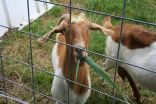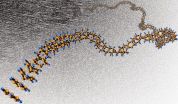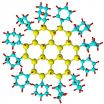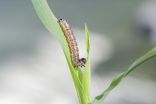(Press-News.org) DURHAM, N.C. -- Herbivores, not herbicides, may be the most effective way to combat the spread of one of the most invasive plants now threatening East Coast salt marshes, a new Duke University-led study finds.
Phragmites australis, or the common reed, is a rapid colonizer that has overrun many coastal wetlands from New England to the Southeast. A non-native perennial, it can form dense stands of grass up to 10 feet high that block valuable shoreline views of the water, kill off native grasses, and alter marsh function.
Land managers traditionally have used chemical herbicides to slow phragmites' spread but with only limited and temporary success.
Now, field experiments by researchers at Duke and six other U.S. and European universities have identified a more sustainable, low-cost alternative: goats.
"We find that allowing controlled grazing by goats or other livestock in severely affected marshes can reduce the stem density of phragmites cover by about half in around three weeks," said Brian R. Silliman, lead author of the new study and Rachel Carson associate professor of marine conservation biology at Duke's Nicholas School of the Environment.
"The goats are likely to provide an effective, sustainable and much more affordable way of mowing down the invasive grass and helping restore lost ocean views," he said.
In fenced-in test plots at the USDA Beltsville Agricultural Research Center in Maryland, Silliman and his colleagues found that a pair of the hungry herbivores could reduce phragmites cover from 94 percent to 21 percent, on average, by the end of the study. Separate trials showed that horses and cows would also readily eat the invasive grass.
In addition to restoring views, the controlled grazing allowed native plant species to re-establish themselves in the test plots over time. The native species diversity index increased five-fold.
"For more than two decades, we've declared major chemical and physical warfare on this grass, using all the latest manmade weapons," Silliman said. "We've used helicopters to spray it with herbicides and bulldozers to remove its roots. More often than not, however, it returns.
"In this study, we show that sustainable, low-cost rotational livestock grazing can suppress the unwanted tall grass and favor a more diverse native plant system," he said.
Silliman said the re-emergence of native marsh plants could happen even faster and be more sustained if managers combine grazing with the selective use of herbicides to eradicate any remaining phragmites and then re-plant native species in its place.
The research findings appear this week in the open-access online journal PeerJ.
"This could be a win-win-win-win situation," Silliman said. Marshes win because native diversity and function is largely restored. Farmers benefit because they receive payment for providing the livestock and they gain access to free pasture land. Managers win because control costs are reduced. Communities and property owners win because valuable and pleasing water views are brought back.
The approach has been used for nearly 6,000 years in parts of Europe and recently has been successfully tested on small patches of heavily phragmites-invaded marshes in New York, he notes. "Now, it just has to be tested on a larger spatial scale."
The only drawback, he added, is that "people have to be okay with having goats in their marsh for a few weeks or few months in some years. It seems like a fair trade-off to me."
INFORMATION:
Funding for the study came from the Royal Netherlands Academy of Arts and Sciences and the Maryland Agricultural Experiment Station.
The study included researchers from Bryn Mawr College; the University of Florida; the University of Maryland; the University of Groningen, Netherlands; PUCCIMAR Ecological Research and Consultancy; and the Royal Netherlands Institute for Sea Research.
CITATION: "Livestock as a Potential Biological Control Agent for an Invasive Wetland Plant," by B.R. Silliman, T. Mozdzer, C. Angelini, J.E. Brundage, P. Esselink, J.P. Bakker, K.B. Gedan, J. van de Koppel and A.H. Baldwin. PeerJ, Sept. 23, 2014. DOI: 10.7717/peerj.567
Goats better than chemicals for curbing invasive marsh grass
Periodic livestock grazing keeps invasive plant in check, helps restore views and biodiversity
2014-09-25
ELSE PRESS RELEASES FROM THIS DATE:
Smallest-possible diamonds form ultra-thin nanothread
2014-09-25
Washington, D.C.— A team including Carnegie's Malcolm Guthrie and George Cody has, for the first time, discovered how to produce ultra-thin "diamond nanothreads" that promise extraordinary properties, including strength and stiffness greater than that of today's strongest nanotubes and polymer fibers. Such exceedingly strong, stiff, and light materials have an array of potential applications, everything from more-fuel efficient vehicles or even the science fictional-sounding proposal for a "space elevator." Their work is published in Nature Materials.
The team—led by ...
Genes causing pediatric glaucoma contribute to future stroke
2014-09-25
(Edmonton, AB) Every year in Canada about 50,000 people suffer from a stroke, caused either by the interruption of blood flow or uncontrolled bleeding in the brain. While many environmental risk factors exist, including high blood pressure and smoking, stroke risk is also frequently inherited. Unfortunately, remarkably little is known regarding stroke's genetic basis.
A study from the University of Alberta, published in the Journal of Clinical Investigation, extends knowledge of stroke's genetic underpinnings and demonstrates that in some cases it originates in infancy.
The ...
Unlocking long-hidden mechanisms of plant cell division
2014-09-25
AMHERST, Mass. – Along with copying and splitting DNA during division, cells must have a way to break safely into two viable daughter cells, a process called cytokinesis. But the molecular basis of how plant cells accomplish this without mistakes has been unclear for many years.
In a new paper by cell biologist Magdalena Bezanilla of the University of Massachusetts Amherst, she and her doctoral student Shu-Zon Wu present a detailed new model that for the first time proposes how plant cells precisely position a "dynamic and complex" structure called a phragmoplast at the ...
Risk of esophageal cancer decreases with height
2014-09-25
Bethesda, MD (Sept. 25, 2014) — Taller individuals are less likely to develop esophageal cancer and it's precursor, Barrett's esophagus, according to a new study1 in Clinical Gastroenterology and Hepatology, the official clinical practice journal of the American Gastroenterological Association.
"Individuals in the lowest quartile of height (under 5'7" for men and 5'2" for women) were roughly twice as likely as individuals in the highest quartile of height (taller than 6' for men and 5'5" for women) to have Barrett's esophagus or esophageal cancer," said Aaron P. Thrift, ...
Putting the squeeze on quantum information
2014-09-25
CIFAR researchers have shown that information stored in quantum bits can be exponentially compressed without losing information. The achievement is an important proof of principle, and could be useful for efficient quantum communications and information storage.
Compression is vital for modern digital communication. It helps movies to stream quickly over the Internet, music to fit into digital players, and millions of telephone calls to bounce off of satellites and through fibre optic cables.
But it has not been clear if information stored in quantum bits, or qubits, ...
Looking for a spouse or a companion
2014-09-25
New Rochelle, NY, September 25, 2014—The increasing popularity of social media, online dating sites, and mobile applications for meeting people and initiating relationships has made online dating an effective means of finding a future spouse. The intriguing results of a new study that extends this comparison of online/offline meeting venues to include non-marital relationships, and explores whether break-up rates for both marital and non-marital relationships differ depending on whether a couple first met online or offline are reported in an article in Cyberpsychology, ...
World's smallest reference material is big plus for nanotechnology
2014-09-25
If it's true that good things come in small packages, then the National Institute of Standards and Technology (NIST) can now make anyone working with nanoparticles very happy. NIST recently issued Reference Material (RM) 8027, the smallest known reference material ever created for validating measurements of these man-made, ultrafine particles between 1 and 100 nanometers (billionths of a meter) in size.
RM 8027 consists of five hermetically sealed ampoules containing one milliliter of silicon nanoparticles—all certified to be close to 2 nanometers in diameter—suspended ...
A galaxy of deception
2014-09-25
Astronomers usually have to peer very far into the distance to see back in time, and view the Universe as it was when it was young. This new NASA/ESA Hubble Space Telescope image of galaxy DDO 68, otherwise known as UGC 5340, was thought to offer an exception. This ragged collection of stars and gas clouds looks at first glance like a recently-formed galaxy in our own cosmic neighbourhood. But, is it really as young as it looks?
Astronomers have studied galactic evolution for decades, gradually improving our knowledge of how galaxies have changed over cosmic history. ...
The ideal age of sexual partners is different for men and women
2014-09-25
New evolutionary psychology research shows gender differences in age preferences regarding sexual partners.
Men and women have different preferences regarding the age of their sexual partners and women's preferences are better realized than are men's. Regarding the age of their actual sexual partners, the difference is however much smaller. Researchers in psychology at Åbo Akademi University in Turku, Finland, suggest that this pattern reflect the fact that when it comes to mating, women control the market.
Grounding their interpretation in evolutionary theory, the ...
Playing tag with sugars in the cornfield
2014-09-25
This news release is available in German. Sugars are usually known as energy storage units in plants and the insects that feed on them. But, sugars may also be part of a deadly game of tag between plant and insect according to scientists at the Max Planck Institute for Chemical Ecology. Grasses and crops such as maize attach sugars to chemical defenses called benzoxazinoids to protect themselves from being poisoned by their own protective agents. Then, when an insect starts feeding, a plant enzyme removes the sugar to deploy the active toxin. The Max Planck scientists ...
LAST 30 PRESS RELEASES:
Numbers in our sights affect how we perceive space
SIMJ announces global collaborative book project in commemoration of its 75th anniversary
Air pollution exposure and birth weight
Obstructive sleep apnea risk and mental health conditions among older adults
How talking slows eye movements behind the wheel
The Ceramic Society of Japan’s Oxoate Ceramics Research Association launches new international book project
Heart-brain connection: international study reveals the role of the vagus nerve in keeping the heart young
Researchers identify Rb1 as a predictive biomarker for a new therapeutic strategy in some breast cancers
Survey reveals ethical gaps slowing AI adoption in pediatric surgery
Stimulant ADHD medications work differently than thought
AI overestimates how smart people are, according to HSE economists
HSE researchers create genome-wide map of quadruplexes
Scientists boost cell "powerhouses" to burn more calories
Automatic label checking: The missing step in making reliable medical AI
Low daily alcohol intake linked to 50% heightened mouth cancer risk in India
American Meteorological Society announces Rick Spinrad as 2026 President-Elect
Biomass-based carbon capture spotlighted in newly released global climate webinar recording
Illuminating invisible nano pollutants: advanced bioimaging tracks the full journey of emerging nanoscale contaminants in living systems
How does age affect recovery from spinal cord injury?
Novel AI tool offers prognosis for patients with head and neck cancer
Fathers’ microplastic exposure tied to their children’s metabolic problems
Research validates laboratory model for studying high-grade serous ovarian cancer
SIR 2026 delivers transformative breakthroughs in minimally invasive medicine to improve patient care
Stem Cell Reports most downloaded papers of 2025 highlight the breadth and impact of stem cell research
Oxford-led study estimates NHS spends around 3% of its primary and secondary care budget on the health impacts of heat and cold in England
A researcher’s long quest leads to a smart composite breakthrough
Urban wild bees act as “microbial sensors” of city health.
New study finds where you live affects recovery after a hip fracture
Forecasting the impact of fully automated vehicle adoption on US road traffic injuries
Alcohol-related hospitalizations from 2016 to 2022
[Press-News.org] Goats better than chemicals for curbing invasive marsh grassPeriodic livestock grazing keeps invasive plant in check, helps restore views and biodiversity






